Oaxaca Day of The Dead: The Ultimate Guide [2024]
Disclosure: This post may contain affiliate links, meaning that I may get a small commission if you decide to make a purchase through my links, at no cost to you.
Planning a trip to see the amazing Oaxaca Day of the Dead festivities?
The Oaxaca Día de los Muertos festival (using the Spanish term) is one of the most recognisable events on earth and an absolute bucket-list must for any keen traveller!
In this article we take you through what the festival is, when it happens, what you can expect, how to get there and offer you lots of tips on how to have the best time possible.
Let’s get right to it!
OAXACA DAY OF THE DEAD
OAXACA DAY OF THE DEAD
What is the Oaxaca Day of the Dead Festival?
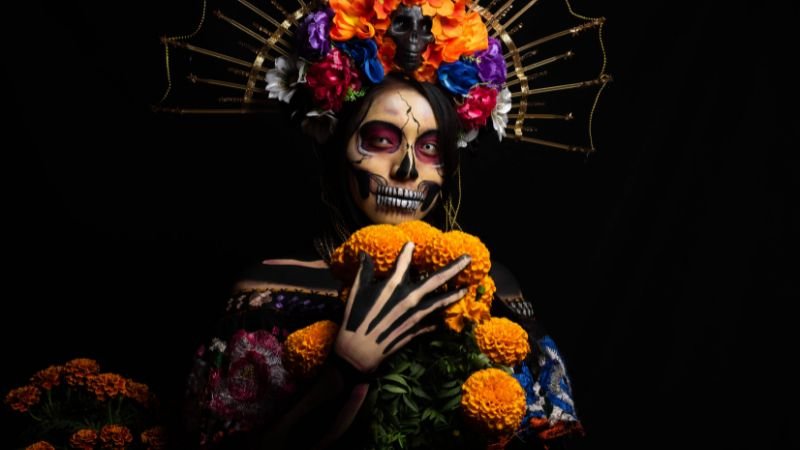
The Day of the Dead (Día de los Muertos) festival in Oaxaca is a captivating and deeply-rooted cultural celebration that pays homage to deceased loved ones.
Its uniqueness comes from it being a blend of indigenous traditions and Catholic influences, creating a colorful yet deeply meaningful commemoration.
Far from being a somber occasion, it’s actually a joyous celebration of life, where death is not feared but embraced as a natural part of the human experience.
Throughout the festival, Oaxaca’s streets and cemeteries come alive with color, music, and traditions.
Families gather at gravesites to clean, decorate, and share stories of their departed loved ones. Elaborate parades, known as comparsas, fill the streets with dancers, musicians, and participants dressed as joyful skeletons and Catrinas (more on this below!).
Oaxacan families believe that during this time, the spirits of their loved ones return to the earthly realm to enjoy the offerings and festivities prepared for them.
The Day of the Dead Festival is a time when the lines between the living and the deceased blur, fostering a sense of connection and continuity.
It’s a celebration that beautifully encapsulates Oaxaca’s rich cultural heritage, blending spirituality, artistry, and a profound reverence for life and death.
And like most great things, it also has a very interesting history.
OAXACA DAY OF THE DEAD
What Is The History Of The Day Of The Dead In Mexico?
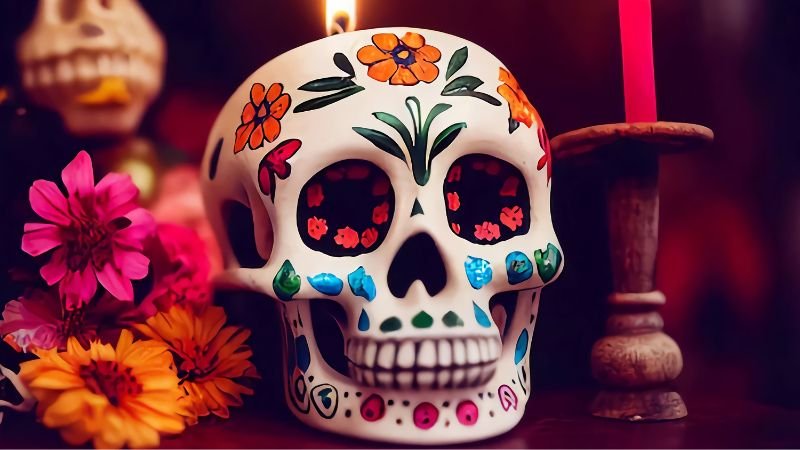
Celebrations of the dead in Mexico are thought to pre-date the Aztec empire, which formed around 1427 AD.
The people of the Aztec empire worshipped a number of gods, among them Mictecacíhuatl, the goddess of death and the underworld.
The Aztecs honored Mictecacíhuatl annually during the ninth month of the Aztec calendar. The festival lasted the whole month of 20 days, during what would now be late July and early August.
Offerings were made to Mictecacíhuatl to ensure the peaceful journey of souls to the afterlife. It is believed that this foundation laid the groundwork for Oaxaca’s contemporary Day of the Dead celebrations.
When the Spanish colonizers arrived in the 16th century, they brought with them Catholicism and its own practices surrounding death and remembrance. The colonizers sought to suppress the local religion and culture, which led to a fusion of indigenous customs and Catholic rituals.
It isn’t a coincidence that the modern Day of the Dead celebration coincides with the Catholic All Saints’ Day and All Souls’ Day. This was a deliberate strategy by the Spanish to merge the indigenous observance with their own religious calendar.
Today, the history of Oaxaca’s Day of the Dead is a celebration that bridges the past and the present and embraces a unique perspective on life, death, and the enduring connection between generations.
Let’s take a look at how long the modern version of the Oaxaca Day of the Dead festival goes for each year.
OAXACA DAY OF THE DEAD
How Long Does The Day Of The Dead Last In Oaxaca?
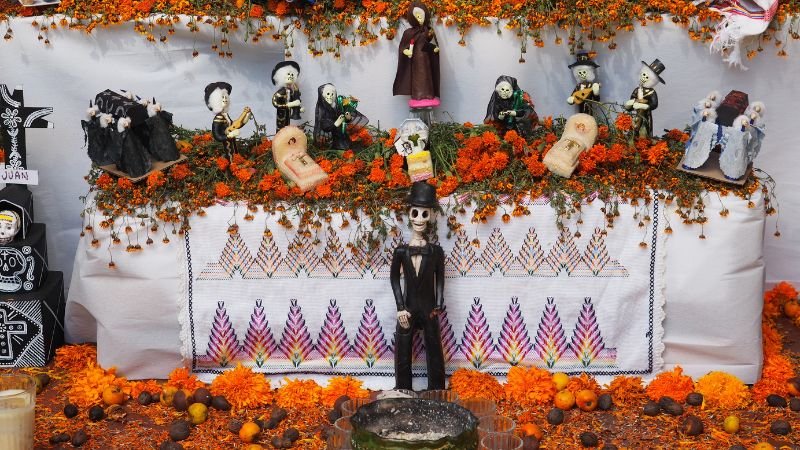
The Day of the Dead Oaxaca Festival is a multi-day celebration that begins on October 31st and continues to November 2nd.
This three-day period allows for various traditions and activities to take place, each with its own significance.
October 31st: Preparing for the Arrival of Spirits
The Oaxaca Day of the Dead festival commences on October 31st with preparations for the imminent return of departed souls.
Families meticulously clean and decorate the gravesites of their loved ones, creating a welcoming environment for their spirits to reunite with the living.
Intricate altars, or ofrendas, are assembled in homes, adorned with marigold petals, candles, and the favorite foods and cherished belongings of the departed.
The aromas of copal incense fill the air, guiding the spirits’ journey back to the earthly realm.
November 1st: Día de los Angelitos (Day of the Little Angels)
November 1st, All Saints Day in the Catholic Church calendar, is dedicated to the spirits of deceased children.
Families lovingly set up altars and offerings specifically designed to delight the little ones.
Toys, sweets, and small belongings are placed on the ofrendas, creating a sense of playfulness and innocence amidst the solemnity.
In cemeteries, graves are adorned with miniature sugar skulls, toys, and vibrant decorations.
The day is a poignant blend of mourning and celebration, as families honor the lives that were cut short while rejoicing in their memory.
November 2nd – Día de los Muertos (Day of the Dead)
The culmination of the festival occurs on November 2nd, when Oaxaca commemorates all departed souls, adults and children alike. In the calendar of the Catholic Church, this is also known as All Souls Day.
Cemeteries become a focal point, transformed into illuminated realms of color and light.
Families gather for picnics, music, and heartfelt conversations with their loved ones’ spirits.
The joyful atmosphere radiates as stories are shared, laughter resounds, and bonds are reaffirmed.
Candles flicker and marigold petals pave the paths between realms, guiding the souls back to their temporary homes.
This day is a powerful testament to Oaxaca’s embrace of death as an integral part of life, where memories are cherished, spirits are honored, and the living are reminded of their enduring connection with those who have passed on.
Let’s look now at specifically how Oaxaca Day of the Dead is celebrated.
OAXACA DAY OF THE DEAD
How Do You Celebrate Day Of The Dead In Oaxaca?
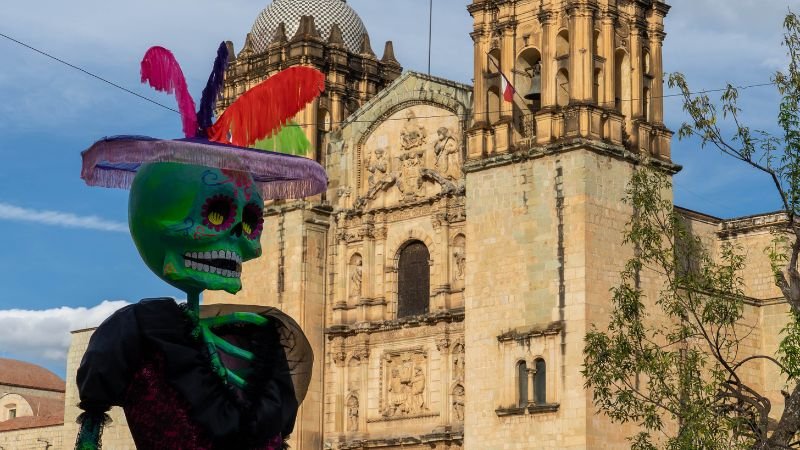
The celebration of Day of the Dead (Día de los Muertos) in Oaxaca is celebrated with various traditions and customs.
Each of these different aspects contributes to a colorful tapestry that honors the deceased and celebrates the cycle of life and death.
Ofrendas
Central to the Oaxacan celebration of Day of the Dead are ofrendas, or altars, lovingly constructed in homes, cemeteries, and public spaces.
These intricate displays are adorned with an array of meaningful items, including candles, incense, and papel picado (colorful cut paper).
The altars are designed to welcome the spirits of the departed, featuring photographs, personal belongings, and even the deceased’s favorite foods and drinks.
Marigold petals are also scattered to create vibrant paths for the spirits to follow.
Calaveras (Sugar Skulls)
Calaveras, or sugar skulls, are an iconic symbol of Oaxaca’s Day of the Dead celebrations.
These intricately decorated confections are often personalized with the names of the deceased and are placed on ofrendas.
They symbolize the fleeting nature of life and the sweetness of memories.
Additionally, many people paint their faces as astonishingly beautiful calaveras, adopting a playful and joyful approach to honoring death.
Visiting Cemeteries
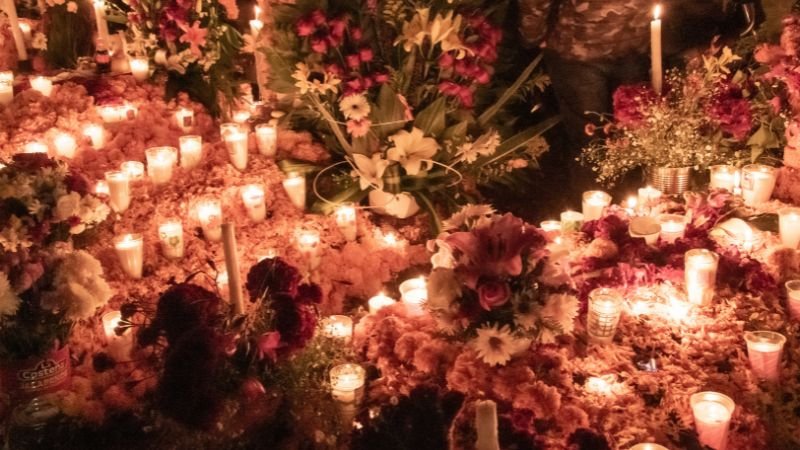
Cemeteries become vibrant spaces during Day of the Dead in Oaxaca, as families gather to clean and decorate the graves of their loved ones.
Tombs are adorned with marigolds, candles, and incense, creating an atmosphere that blurs the line between the spiritual and the earthly.
Families spend the day picnicking, sharing stories, and engaging in heartfelt conversations with the spirits of their departed.
Comparsas (Street Processions)
Comparsas, or street processions, are a lively and communal aspect of Oaxacan Day of the Dead celebrations.
Participants dress up as joyful skeletons, known as Catrinas and Catrines, and parade through the streets accompanied by music, dancing, and revelry.
These processions serve as a joyful reminder that death is not to be feared but embraced as an integral part of life’s journey.
Church Observances and Masses
Oaxaca Day of the Dead also holds religious significance, with many attending church services and masses during the festival period.
These observances offer moments of reflection, prayer, and remembrance for the departed.
The spiritual component of the celebration underscores the blend of indigenous beliefs and Catholic traditions that characterize Oaxacan culture and Oaxaca Day of the Dead in particular.
Marigold Flowers

Marigold flowers, or cempasúchil, hold special significance during the Oaxaca Day of the Dead festival.
Their vibrant orange and yellow hues are believed to guide the spirits of the departed back to the earthly realm.
These flowers are scattered in intricate patterns, forming colorful pathways that are believed to lead the souls to their ofrendas and loved ones.
La Catrina
La Catrina is an elegant skeleton woman adorned in fashionable attire who has become an iconic symbol of the Oaxaca Day of the Dead festivities.
Created by Mexican illustrator José Guadalupe Posada, La Catrina serves as a reminder of the universality of death and the importance of embracing it with dignity and humor.
Many Oaxacan celebrations feature individuals dressed as La Catrina, embodying a playful yet profound representation of mortality.
Sand Tapestries
In certain Oaxacan communities, intricate sand tapestries (tapetes de arena) are created during Day of the Dead festivities.
Skilled artisans meticulously arrange colored sand to depict elaborate scenes, often featuring calaveras, angels, and other symbolic elements.
These ephemeral artworks showcase the intersection of artistic expression and spiritual devotion for which Oaxaca is famour.
Pan de Muerto
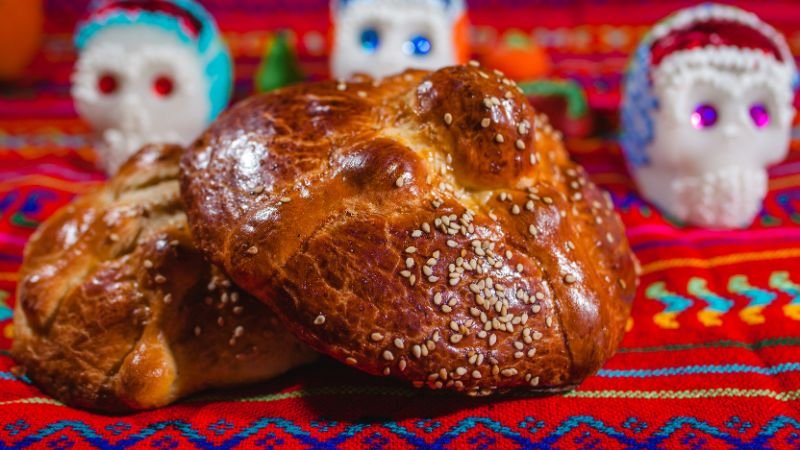
Pan de muerto, or bread of the dead, is a culinary delight synonymous with the Oaxaca Day of the Dead celebration.
This round, sweet bread is often adorned with bone-shaped decorations on top, representing the cycle of life and death.
Families prepare and share pan de muerto on ofrendas, ensuring that departed loved ones can partake in the festive feasting.
Mojigangas (Giant Puppets)
Mojigangas, or giant puppets, add an element of whimsy and theatricality to the Oaxaca Day of the Dead festivities.
These towering figures, often depicting skeletons and whimsical characters, are paraded through the streets during comparsas (street processions).
The mojigangas embody the spirit of celebration, infusing the atmosphere with joy and playfulness as they dance and interact with the crowds.
Alebrijes
Alebrijes are fantastical, handcrafted creatures that have become an integral part of Oaxaca’s Day of the Dead celebrations.
These intricate sculptures feature vibrant colors, intricate patterns, and imaginative designs.
Traditionally carved from wood and elaborately painted, alebrijes are believed to possess protective qualities and guide the spirits of the departed to their families’ ofrendas.
OAXACA DAY OF THE DEAD
What Is Special About The Day Of The Dead In Oaxaca?
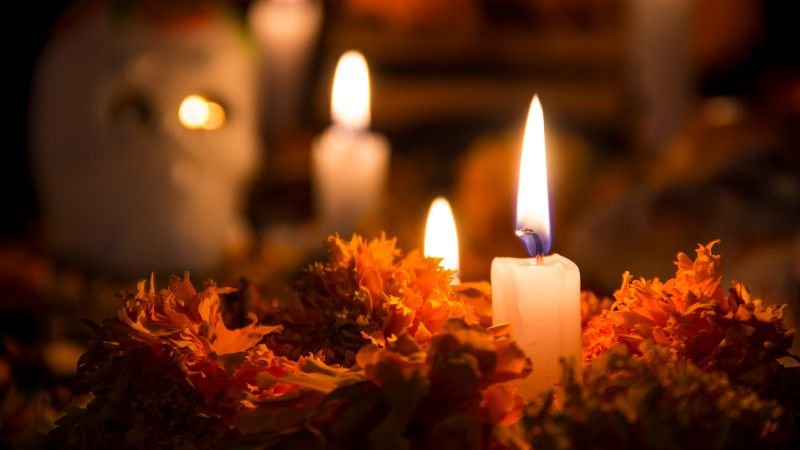
Día de los Muertos in Oaxaca is a uniquely captivating and culturally rich experience that sets it apart from other versions of the festival in Mexico and elsewhere in the world.
The Oaxacan observance of this holiday has several distinctive features that make it truly exceptional. We’ve set out a few of these below.
Blend of Beliefs
Oaxaca’s Day of the Dead celebration is deeply rooted in its indigenous heritage.
Indigenous communities like the Zapotecs and Mixtecs have long held beliefs about honoring the deceased and maintaining a connection with the spiritual world.
Oaxaca’s celebration seamlessly blends pre-Hispanic practices with Catholicism, creating a celebration that pays homage to ancestors and celebrates life’s natural and inevitable cycle.
Familial Ofrendas
Ofrendas, or altars, are a central aspect of Oaxaca’s celebration, which is not the case in other regions of Mexico.
Families meticulously craft these colorful displays with marigold petals, candles, and cherished items of their departed loved ones.
Personalized offerings, including favorite foods and beverages, create an inviting space for spirits to return and reconnect with the living, forging an intimate link between past and present.
La Catrina
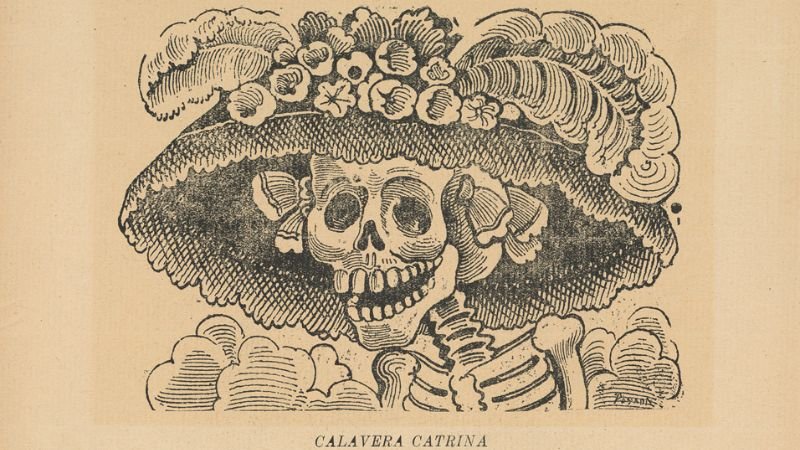
Effigies of La Catrina, the elegantly dressed skeleton woman, are also a uniquely Oaxacan twist on the Day of the Dead celebrations.
While other festivals do feature La Catrina, the emphasis in the Oaxacan Día de los Muertos festival makes Oaxaca Day of the Dead something special.
Community Cohesion
Oaxaca Day of the Dead is a celebration that fosters community bonds. This isn’t as obvious in some of the larger cities in Mexico such as Mexico City where other large Day of the Dead celebrations take place.
In Oaxaca, families collaborate to clean and decorate cemeteries, sharing stories, laughter, and memories.
Comparsas, lively street processions, invite neighbors and visitors to partake in the joyful revelry, creating a collective celebration that transcends generations.
There is an intimacy and depth to the Oaxaca Day of the Dead that is not often found in other prominent Día de los Muertos celebrations.
Artistic Expression
Oaxaca’s artisanal heritage in creative mediums like alebrijes and sand tapestries is delightfully integrated into Oaxaca Day of the Dead festivities.
These imaginative sculptures and intricate artworks are not only stunning visual displays but also carry spiritual significance.
The wonderfully colorful and fantastical alebrijes are believed to guide departed spirits, while sand tapestries capture the essence of the transient nature of life.
Let’s take a closer look at this by comparing Oaxaca Day of the Day to the grander and choreographed version in Mexico City.
OAXACA DAY OF THE DEAD
Is Day Of The Dead Better In Oaxaca Or Mexico City?
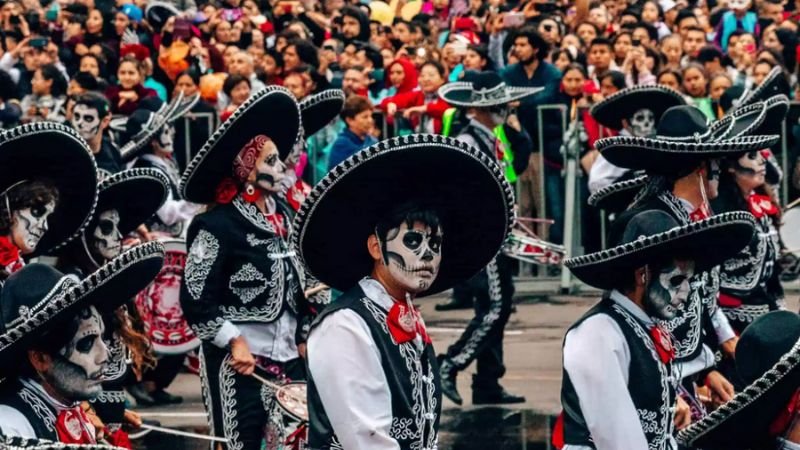
Let’s be honest – Day of the Dead in either Oaxaca or Mexico City is going to be simply fantastic.
So we should be clear that neither option is bad. But is it better to experience the one or the other?
The answer is that both regions offer unique and captivating experiences that resonate with different preferences and interests. Each destination brings its own cultural nuances, traditions, and atmosphere to it, making the choice a matter of personal perspective.
We’ve highlighted some of the contrasting aspects below.
Key Aspects of Oaxaca Day of the Dead
Overall, Oaxaca Day of the Dead is a more intimate and communal experience than Mexico City Day of the Dead.
Oaxaca also integrates some of its unique artisanal pedigree and indigenous traditions into the festival.
Indigenous Roots
Oaxaca’s Day of the Dead celebration is deeply rooted in its indigenous heritage.
Indigenous communities like the Zapotecs and Mixtecs have preserved ancestral practices, creating a celebration that seamlessly blends pre-Hispanic beliefs with Catholicism.
For travelers seeking an authentic encounter with indigenous culture, Oaxaca offers a genuine and immersive experience.
Ofrendas and Personal Connection
Oaxaca’s ofrendas (altars) are meticulously crafted, with marigold petals, candles, and the favorite foods of the departed.
These personalized offerings create an intimate and spiritual connection between the living and the deceased.
Oaxaca’s ofrendas exude a sense of authenticity and heartfelt remembrance.
La Catrina, Mojigangas and Alebrijes
Oaxaca’s celebrations feature a unique artistic and artisanal flair.
La Catrina, the elegant skeleton woman, adds a touch of playfulness to the reverence of the holiday.
The use of mojigangas, the giant puppets, infuses the festivities with theatrical flair and whimsy.
And the outrageous Oaxacan alebrijes bring a sense of the fantastic to the whole experience.
Key Aspects of Mexico City Day of the Dead
In Mexico City, Día de los Muertos is a far grander affair, befitting a major city of its size and importance.
Day of the Dead in Mexico City is more organised and structured than Oaxaca Day of the Dead, using stages and holding larger and more visually stunning parades.
Grand Altar
Mexico City erects a grand altar in the historic Zócalo square, creating a breathtaking centerpiece that draws locals and visitors alike.
The elaborate decorations and symbolic elements contribute to a larger-than-life spectacle that embodies the urban vibrancy of the city.
Desfiles de Día de Muertos
Mexico City hosts grand parades, known as Desfiles de Día de Muertos, which feature giant calaveras, floats, and exuberant participants.
These lively processions showcase the city’s artistic prowess and offer a unique public dimension to the celebration.
Urban Twist on Tradition
While Oaxaca celebrates with a more traditional and intimate approach, Mexico City’s celebration reflects its metropolis status by embracing grandeur and innovation.
For those who prefer a modern twist on tradition, Mexico City provides a dynamic and visually stunning experience.
Choosing Between Oaxaca and Mexico City: Personal Preferences
The decision between Oaxaca and Mexico City for celebrating the Day of the Dead ultimately comes down to personal preferences.
If you’re looking for an immersive experience in indigenous culture, authentic ofrendas, and a traditional ambiance, Oaxaca is a compelling choice.
On the other hand, if you’re drawn to the energy of an urban extravaganza, grand altars, and vibrant parades, Mexico City’s celebration might be more aligned with your tastes.
They do have one thing in common, though, which is how the attendees dress for the festival! Let’s take a closer look at this.
OAXACA DAY OF THE DEAD
How Do You Dress For Day Of The Dead?
The Day of the Dead (Día de los Muertos) celebration in Oaxaca is a vibrant and culturally rich event that holds special significance for locals and visitors alike.
As you immerse yourself in the festival, dressing appropriately can enhance your experience and show respect for the traditions and customs of the region.
Here’s how to dress for Oaxaca Day of the Dead, with tailored advice for both men and women.
Dressing for Men
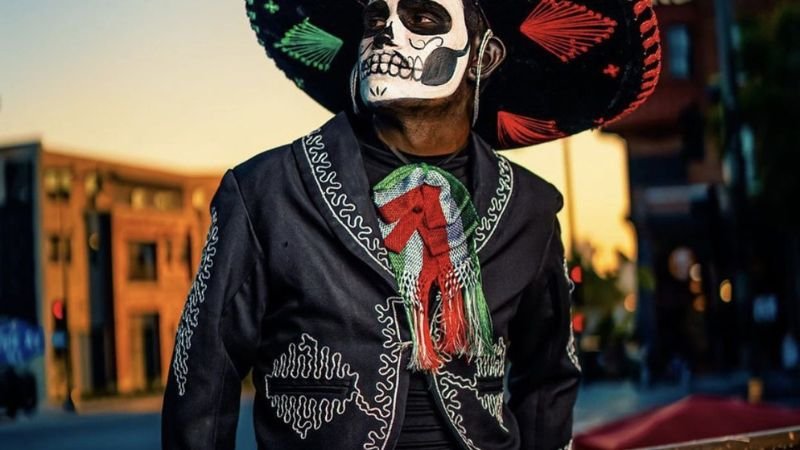
Men attending Oaxaca Day of the Dead festivities and who are looking to adopt traditional Mexican attire can opt for a charro outfit or a guayabera shirt.
A charro outfit is a traditional Mexican costume worn by skilled horsemen and ranchers knowns as charros. It typically includes a wide-brimmed hat, fitted jacket adorned with intricate embroidery, tight-fitting pants or chaps, a bowtie, and boots.
It is often worn during festive events and pays homage to Mexican ranching heritage, adding a touch of elegance to the occasion.
If you would prefer something on the more casual side, a classic white guayabera shirt is a versatile choice that exudes a refined yet relaxed look.
The guayabera‘s pleated front and distinctive double row of pockets make it a favored choice for festive occasions.
Dressing for Women
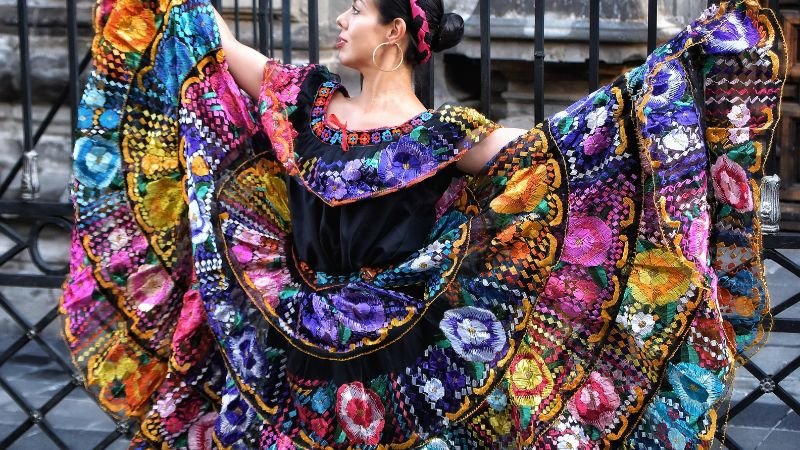
Women can embrace the vibrancy of Oaxacan culture by wearing a huipil, a beautifully embroidered traditional blouse, paired with a colorful skirt.
These ensembles are not only stylish but also pay homage to the region’s rich textile heritage.
A rebozo, a shawl-like garment typically in the highly detailed artisanal patterns that Oaxaca is known for, adds an elegant touch to any outfit. Drape it gracefully or use it to create intricate hairstyles.
You can add floral accessories such as flower crowns or hairpins to your outfit to give it that final touch.
Choosing Footwear

For both men and women, comfortable footwear is essential for navigating the bustling streets and cemeteries during the celebration.
A great option are huaraches. Huaraches are traditional Mexican sandals that have been worn for centuries. They are known for their distinctive woven leather or fabric straps that form a pattern across the foot.
Huaraches are often handmade and come in various styles, colors, and designs. The sole of a huarache can be made from leather or rubber, providing comfort and durability.
They are known for their breathability and comfort, making them suitable for warm climates like that of Oaxaca.
Face Paint and Makeup

Both men and women have the option to paint their faces as calaveras, embracing the playful and artistic aspect of the holiday.
Oaxaca Day of the Dead face paints are used to create beautiful skull designs, symbolizing the joyous connection between the living and the departed.
OAXACA DAY OF THE DEAD
What Is The Best Itinerary For Oaxaca Day Of The Dead?
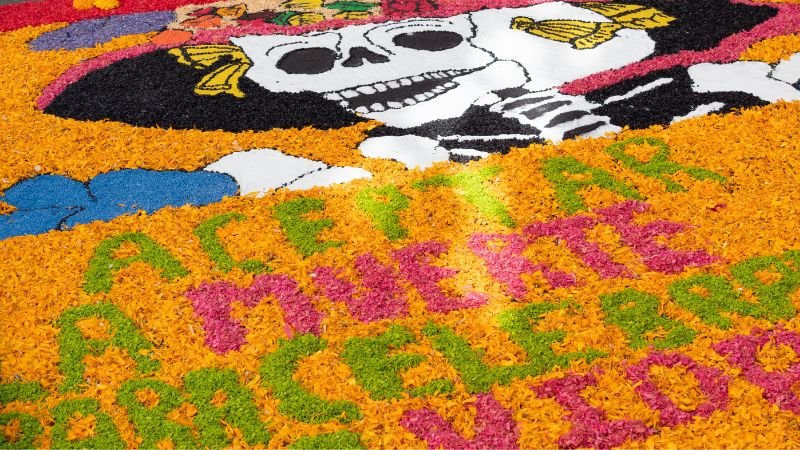
Oaxaca Day of the Dead is a unique and culturally rich experience that spans three days, each with its own significance and activities.
If you are like me and love a list, it will be helpful for you to have a detailed itinerary to ensure you make the most of this vibrant celebration.
We’ve suggested a great itinerary below that you can use as a starting point.
October 31 – Noche de Ánimas (Night of the Souls)
October 31 marks the opening of the Oaxaca Day of the Dead festivities. It is known as Noche de Ánimas (Night of the Souls).
A great way to start your Oaxaca Day of the Dead journey is by spending the morning exploring Oaxaca’s bustling markets like Mercado Benito Juárez.
You can eat some great Oaxacan food, buy finishing touches like marigold flowers for your outfit or just watch locals shop while soaking in the bustling market atmosphere.
If you’re keen to see the sights while you wait for the evening to come, a day trip to the Zona Arqueológica de Monte Albán is a great option. It’s only six miles from Oaxaca, yet is one of the best known Zapotec archaeological sites in Mexico.
By 31 October, many families have already substantially decorated the gravestones of their family members. You can spend the afternoon visiting local cemeteries such as the Panteón General to see the beautiful marigold flowers, candles, and incense arranged to create ofrendas (altars).
The cemeteries are open to the public, however, do remember to be respectful as there is a solemn side of the Oaxaca Day of the Dead festival. Ask before photographing anyone or their ofrendas, and try not to intrude on any families that would prefer privacy.
In the evening, Oaxaca’s streets come alive with the Magna Comparsa. Don’t miss it! It’s a lively and colorful grand parade featuring traditional dances, mojigangas (giant puppets) and locals dressed in vibrant costumes.
November 1 – Dia de los Angelitos (Day of the Little Angels)
Día de los Angelitos is dedicated to honoring the spirits of deceased children.
If you return to the cemeteries, you will see families refreshing the ofrendas and redecorating gravesites. They often also bring the favorite foods, toys, and belongings of the departed children to the ofrendas, creating a welcoming environment.
Having officially opened the night before, the city is now bursting with comparsas (parades), and you’ll see lively processions, traditional costumes, music, and dance everywhere. A great option is to find a rooftop bar where you can watch the parades from above while relaxing with a cocktail or some amazing Oaxacan food.
If you want to do another day trip, an excursion to Hierve el Agua should be high on your list. Hierve el Agua is a petrified waterfall a little over 40 miles to the east of Oaxaca, which looks somewhat other-worldly with its reef-like beautiful mineral pools.
If you want to experience a next-level comparsa, you can also take a taxi to San Agustín Etla. San Agustín Etla is a small town around 10 miles north of Oaxaca which is known for its outrageous comparsas that the local performers often spend months preparing.
November 2 – Dia de los Muertos
November 2, the true Día de los Muertos, is the pinnacle of the Oaxaca Day of the Dead celebrations. For local families, this is the time for them to say a peaceful and heartfelt farewell to the spirits of the dead family members.
Families continue to visit cemeteries to honor the departed, and the focus has now shifted from children to adult family members. Ofrendas are refreshed once again with the deceased’s favorite foods, beverages, and belongings.
It is worth visiting a cemetery again in the evening to see how they have changed over the three day period, even if you think you’ve seen enough of them by now. Particularly in the evening, the cemeteries will come alive again, but with a more solemn atmosphere, as families say their farewells.
During the day, you should visit the Palacio de Gobierno to see the enormous tapetes de arena (sand murals) that are created each year for the Oaxaca Day of the Dead festival. You may see others from time to time in shops or on the street, and they are impressive and often very detailed.
If you haven’t already been there, you should check out the Zócalo, where there is always some music or dance going on in the pavilion. And don’t forget to watch a few of the final beautiful comparsas as they make their way through the city.
OAXACA DAY OF THE DEAD
What Food Is Served During Oaxaca Day Of The Dead?

The Oaxaca Day of the Dead (Día de los Muertos) celebration is not only a time for honoring departed loved ones but is also a culinary feast for the senses.
Culinary offerings play a significant role in this cultural observance, reflecting a blend of indigenous traditions and Catholic influences.
From pan de muerto to traditional dishes such as mole and tamales, the food served during Oaxaca Day of the Dead is one of the best things to experience.
Some of the foods that you will see are used by families on their ofrendas (altars) that they construct on the graves of the passed family members.
In addition to the foods you will often see adorning ofrendas, there are a number of other traditional Oaxacan foods that take centre-stage during the Oaxaca Day of the Dead festivities. There are also several tasty Oaxacan beverages of which you can partake whilst at Oaxaca Day of the Dead.
We’ve set out just a few of these below.
Pan de Muerto
At the heart of the ofrendas (altars) lies pan de muerto, a round sweet bread adorned with bone-shaped decorations.
This symbolic bread, infused with anise and orange blossom, represents the cycle of life and death.
Families lovingly place pan de muerto on the altars, inviting the spirits of the departed to partake in the feast.
Calaveras de Azúcar (Sugar Skulls)
Sugar skulls (calaveras de azúcar) are not only ornate decorative and colorful but are also edible tokens of remembrance.
These intricately crafted confections are often personalized with the names of the deceased and serve as a whimsical representation of mortality.
They are lovingly arranged on ofrendas, embodying the duality of life and death.
Mole Negro
Mole negro is a luscious dark-colored sauce crafted from a blend of chiles, chocolate, and spices.
It is a well-known Oaxacan delicacy often served over turkey or chicken, offering a harmonious blend of sweet and savory flavors.
During Oaxaca Day of the Dead, perhaps because of its dark colour, you’ll see a lot of people sampling this Oaxaca gem.
Tamales
Tamales are an ancient traditional food prepared by wrapping corn dough and various fillings such as mole, chicken, or sweet ingredients in corn husks and then steaming them.
They are a simple yet nourishing and tasty staples at Oaxaca Day of the Dead feasts.
Atole
Atole is a comforting corn-based beverage thickened with masa (a type of corn dough) with deep cultural roots.
It’s often flavored with cinnamon, vanilla, chocolate, or fruits and is a frequent choice during the Oaxaca Day of the Dead celebrations.
Oaxacan Hot Chocolate
Oaxacan hot chocolate is a beloved indulgence during the Day of the Dead celebrations and can help you keep warm during your late nights in the cemetery.
It is crafted using rich, stone-ground chocolate mixed with water or milk using traditional artisanal techniques.
It is often mixed with cinnamon, almonds, or vanilla to give it its distinct Oaxacan flavour.
Mezcal
Mezcal has deep traditions in Oaxaca due to its long history of artisanal production that continue to this day.
During the Oaxaca Day of the Dead festival, it is often shared during evening vigils, and serves to keep you warm and perhaps to bring you a little closer to the souls on the other side.
OAXACA DAY OF THE DEAD
Oaxaca Day Of The Dead Tours: Is It Worth It?
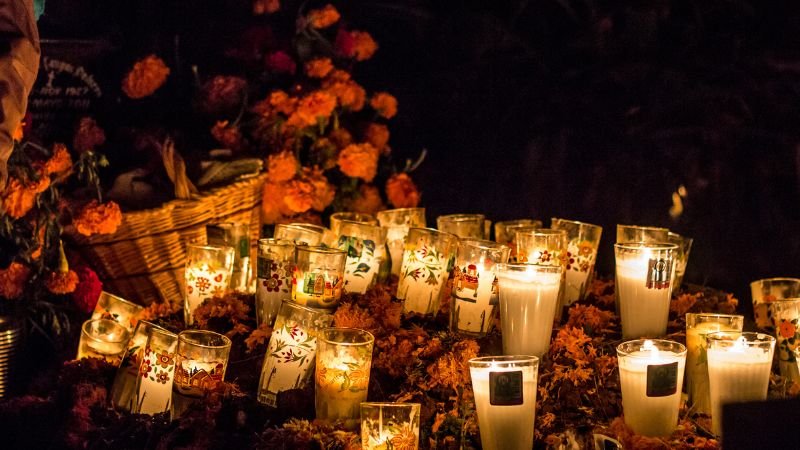
If you’re in Oaxaca for the first time, don’t speak any Spanish, and or you just want to make sure that you visit the best places, booking a Oaxaca Day of the Dead tour could be a great option.
Tours offer you the opportunity to receive expert guidance from local guides who possess in-depth knowledge of the customs, rituals, and history associated with the festival.
These guides can provide context to the various elements of the celebration, helping you understand the significance of offerings, altars, and traditional practices.
Tour guides are also great facilitators. Like it or not, as a tourist you’ll usually be regarded as an outsider, and while you may find people willing to invite you into their private experience, it’s not a certainty. A tour guide can act as your interface with the local people you are trying to get to know.
By joining a tour, the tour guide can also help you navigate the local customs, ensuring that you engage respectfully with the community and the spirits being honored. No one wants to be the person who puts his proverbial foot in his mouth, and your tour guide can help you prevent that from happening.
Tours are also often granted exclusive access to events, cemeteries, and workshops that may not be accessible to independent travelers. This can provide a more authentic and immersive experience, allowing you to connect with locals and witness the traditions firsthand.
Lastly, tours often handle logistics and transportation. This lets you to relax a little more than otherwise, allowing you to focus on the experience itself without worrying about the details. You can focus instead on meeting like-minded travelers, fostering connections and shared memories.
Overall, a guided tour for Oaxaca Day of the Dead is a solid option, especially if you are a first-timer or don’t feel confident navigating your way around the festival.
OAXACA DAY OF THE DEAD
How Do People Celebrate Day Of The Dead Respectfully?

Oaxaca Day of the Dead is a deeply meaningful and culturally significant celebration in Oaxaca. While this festive occasion welcomes participation from visitors, it’s essential to engage in a manner that honors the traditions, values, and spiritual significance of the holiday.
Here are five tips on how to celebrate Oaxaca Day of the Dead respectfully, ensuring your participation is both meaningful and culturally sensitive.
Educate Yourself
This one should be obvious, but you don’t want to be the elephant in the china shop at Oaxaca Day of the Dead.
You can easily avoid this if you take just a few simple steps.
Do: Research and Learn
Before participating in Day of the Dead festivities, take the time to understand the cultural and historical significance of the celebration.
Learn about the indigenous roots, symbolic elements, and the profound connection between the living and the deceased.
Don’t: Assume or Disregard
Avoid participating blindly or approaching the holiday with preconceived notions.
Disregarding the meaning behind the customs and symbols can lead to unintentional disrespect and will definitely result in you not having as great a time as you could.
OAXACA DAY OF THE DEAD
Observe and Learn from Locals
You’ll have the best time possible if you take a few small steps to fit in.
Here’s how to do it.
Do: Observe and Follow Local Customs
When attending Day of the Dead events, observe how locals engage with the traditions.
Take cues from their behavior, such as how they interact with ofrendas, light candles, and participate in ceremonies.
Don’t: Intrude or Disrupt
Respect personal space and cultural practices. Avoid intruding into private family ceremonies or taking intrusive photographs without permission.
OAXACA DAY OF THE DEAD
Be Respectful
It can be easy to forget that there is a solemn aspect to Oaxaca Day of the Dead that underlies the colorful dancing, signing and decorations.
It’s important to be respectful of the beliefs of local Oaxacans whilst participating in the festivities.
Here are a few things to do and to avoid to help explain this:
Do: Create Your Own Ofrenda
If a family invites you to do so, you can create a small ofrenda as a respectful way of participating and acknowledging their beliefs and culture.
Needless to say, this should be heartfelt and should include items that hold personal meaning or significance to your own loved ones.
Don’t: Intrude on Family Altars
The ofrendas that you see are created by families and are essentially personal property. You shouldn’t interfere with them without their express invitation and permission.
Remember that those altars are intimate spaces dedicated to specific individuals, and altering them can be seen as disrespectful.
OAXACA DAY OF THE DEAD
Dress Appropriately and Respectfully
It may not necessarily be apparent from the flamboyant and colorful clothing worn by local Oaxacans, but Oaxaca is actually quite conservative.
This is even more the case during Oaxaca Day of the Dead, when families dress up to meet their returning family members.
As such, you need to consider what your choice in clothing says about you when you participate in Oaxaca Day of the Dead.
Do: Dress Mindfully
Choose attire that respects the occasion’s reverence and cultural significance.
If you decide to paint your face as a calavera (skull), do so with artistic sensitivity.
Don’t: Wear Offensive Costumes
Avoid wearing costumes that mock or trivialize the holiday’s traditions. In particular, Oaxaca Day of the Dead is not Halloween, so leave your Halloween costumes at home!
You also need to be aware that there are the comparsas, where flamboyance is encouraged, and then there are the vigils at the gravesites, which are much more solemn affairs.
As such, if you are dressing up as a calavera, you may want to do so after you have finished observing the families at their gravesites.
OAXACA DAY OF THE DEAD
Mind Your Photography
We mentioned it briefly above, but it bears repeating, as it is such an easy foot to put wrong.
Do: Ask for Permission
When taking photos, especially at cemeteries or private events, always seek permission from those you wish to photograph, and avoid using flash photography.
It should go without saying that you should respect the person’s wishes if he or she declines.
Don’t: Photograph Families During Private Moments
Respect the privacy of individuals and families who are mourning or engaging in personal ceremonies. Intrusive photography can disrupt the solemnity of the occasion.
You also shouldn’t photograph children without express permission from their parents.
OAXACA DAY OF THE DEAD
Oaxaca Day Of The Dead: FAQs
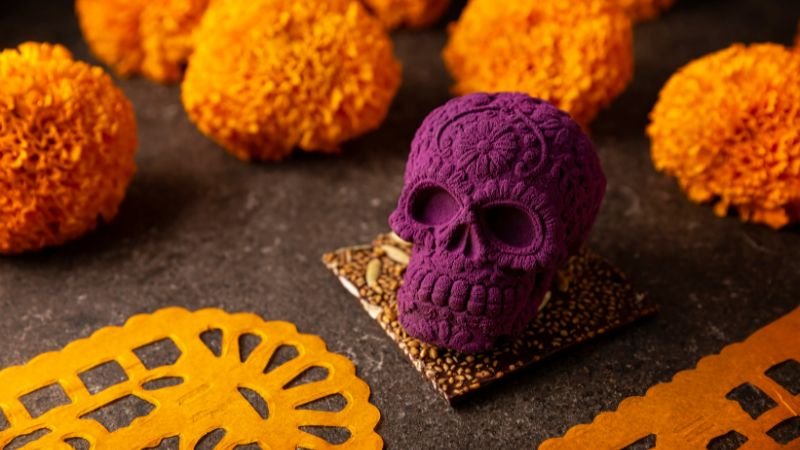
Still have questions?
We’ve set out answers to the most frequently asked questions about Oaxaca Day of the Dead below.
What is Oaxaca Day of the Dead?
Oaxaca Day of the Dead is a vibrant yet meaningful cultural celebration that honors departed loved ones and celebrates the cycle of life and death.
It’s a time when families gather in cemeteries to create ofrendas (altars) adorned with offerings, marigold flowers, candles, and mementos to welcome the spirits of the departed back to the world of the living for a short time.
When does the celebration take place?
The Oaxaca Day of the Dead celebration spans three days: October 31 to November 2.
October 31 is dedicated to preparing for the arrival of the spirits, November 1 is Dia de los Angelitos (Day of the Little Angels), focused on deceased children, and November 2 is Dia de los Muertos (Day of the Dead), honoring adults.
How do people celebrate Oaxaca Day of the Dead?
Families create ofrendas at home and at cemeteries, decorate gravesites with marigold petals and candles, and leave offerings like favorite foods and drinks for the spirits.
Comparsas (parades), cultural performances, and workshops on traditional crafts and intricate face painting are also integral to the celebration and take place all over the city during the Oaxaca Day of the Dead festival.
Can visitors participate in the celebration?
Yes, visitors are welcome to participate in the celebration with respect and sensitivity.
You can engage in workshops, visit cemeteries, and create your own ofrenda. It’s essential to observe and learn from locals, dressing appropriately and honoring the customs.
What is the significance of marigold flowers?
Marigold flowers, known as cempasúchil, are believed to guide the spirits of the departed back to the world of the living.
Their vibrant color and distinctive scent are thought to help guide the way, and they are used to create colorful pathways from ofrendas to gravesites.
What is La Catrina?
La Catrina is an iconic figure of a elegantly dressed female skeleton, often depicted wearing a fancy hat.
It was created by Mexican artist José Guadalupe Posada and has become a symbol of Day of the Dead.
La Catrina represents the idea that death is a natural part of life and should be embraced and celebrated.
What foods are associated with the celebration?
Pan de muerto, a sweet bread adorned with bone-shaped decorations, is a staple.
Tamales, mole, and traditional Mexican hot chocolate are also common.
These offerings are placed on ofrendas and symbolize the connection between the living and the deceased.
Are there any specific dos and don’ts for participating?
Yes, definitely. Here is a quick summary:
Do:
Educate yourself about the holiday’s meaning, observe and learn from locals, create an ofrenda with respect, dress appropriately, ask for permission before taking photos, and engage with sensitivity and curiosity.
Don’t:
Intrude into private ceremonies, take intrusive photographs, wear offensive costumes, or treat the celebration as a tourist spectacle.
What makes Oaxaca Day of the Dead unique?
Oaxaca’s celebration is characterized by its blend of indigenous traditions, Spanish colonial influences, and artistic expressions.
The sand tapestries, intricate face painting, vibrant parades, and deeply personal ofrendas set Oaxaca’s celebration apart, making it a true immersion into the heart of Mexican culture.
1Is Oaxaca Day of the Dead like Halloween?
No. Day of the Dead and Halloween are distinct celebrations with different origins and cultural meanings.
While both occur around the same time and involve themes of death, they have different focuses.
Halloween is often associated with costumes, trick-or-treating, and spooky themes, while Day of the Dead is about honoring and remembering departed loved ones, celebrating their lives, and building connections between the living and the deceased.
Is Oaxaca safe during Day of the Dead?
Yes, Oaxaca is generally safe during the Day of the Dead celebrations.
The city is known for its welcoming atmosphere and vibrant cultural traditions. However, like any travel destination, it’s important to exercise normal caution and be mindful of your surroundings, especially in crowded areas.
Participating in guided tours, staying informed about local events, and respecting local customs will contribute to a safe and enjoyable experience.
Is it Dia de Muertos or Dia de los Muertos?
Both terms are correct and used interchangeably.
“Dia de Muertos” translates to “Day of the Dead” in English, while “Dia de los Muertos” translates to “Day of the Deceased.”
Both variations are recognized and understood, so you can use the one you find more comfortable.
Do you need to speak Spanish at Oaxaca Day of the Dead?
While knowing some basic Spanish phrases can enhance your experience and interactions, it’s not a requirement to fully enjoy Oaxaca Day of the Dead.
Many locals in Oaxaca’s tourist areas speak English, especially those involved in the tourism industry.
Engaging with respect, using simple greetings and expressions, and being open to learning will allow you to connect with locals and understand the significance of the celebration.
OAXACA DAY OF THE DEAD
Day Of The Dead In Popular Culture
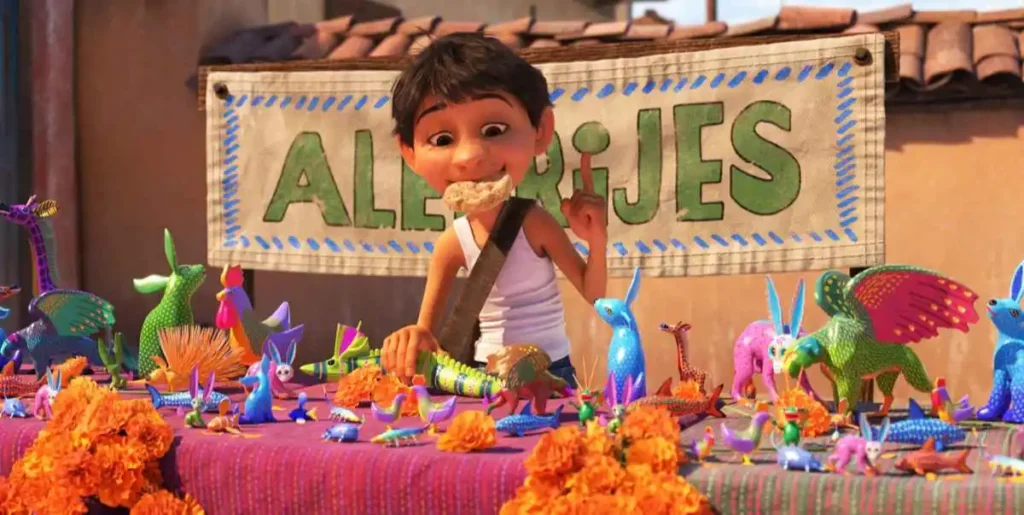
As a result of its immense popularity, Day of the Dead has recently featured in a number of recent blockbuster films.
We’ve set out a few of the most popular of these below.
Coco (2017)
The most recent megafilm featuring the Day of the Dead was the beautifully animated film Coco.
Coco tells the tale of a young boy who rebels against his family’s prohibition on music, going to the underworld to find his long dead musical great-great-grandfather, who left his family to become a famous singer.
The Pixar team of filmmakers travelled to Oaxaca to carry out research, and there are a number of scenes that reminder the viewer of various places or people in Oaxaca.
Spectre (2016)
Spectre is a James Bond film starring Daniel Craig, during which Bond places himself in great danger while seeking out the sinister and secretive underground criminal network known as Spectre.
However, despite being a great film in its own right, for many of us it is the opening scene that is the most memorable.
The film begins with a cinematically brilliant shot of a lavish Day of the Dead parade in Mexico City’s historic centre. The moving scene runs continuously for over 4 minutes and makes you really feel as though the festival is happening all around you in your living room.
If you haven’t seen it, and even if you’re not at all a Bond fan, watch it just for that one scene if for not other reason! Trust me, it’s worth it!
Book of the Dead (2014)
The Book of the Dead is another animated film, this time about a love triangle in a traditional Mexican village.
The film begins during the Day of the Dead festival held in the village, where two young boys are competing for the love of a girl in the village, María.
Spirits from underworld realms place a wager on which of the boys will ultimately be successful in winning María’s heart. The tale then follows the lives of the children as they become adults and continue to compete for the hand of the beautiful María.
This is a great film that features loads of the traditional practices, foods, decorations, and cultural meanings associated with the Day of the Dead celebration in Oaxaca.
OAXACA DAY OF THE DEAD
Oaxaca Day of The Dead In Nearby Towns and Villages
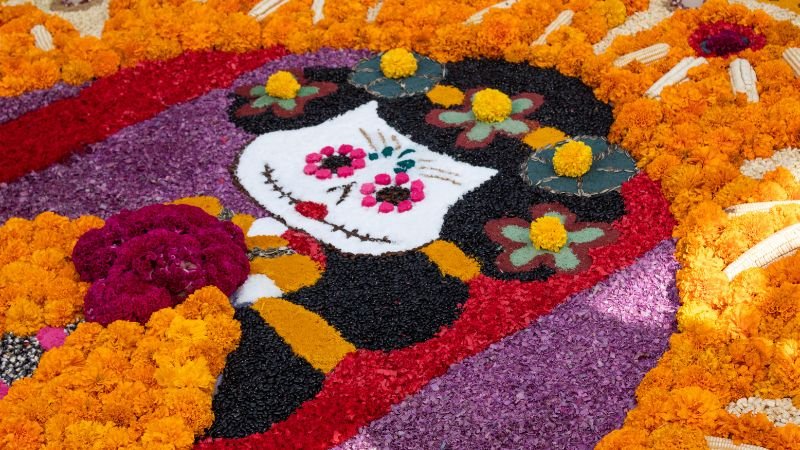
Oaxaca is a diverse region of Mexico, and many towns and villages have their own traditions in relation to Day of the Dead that differ somewhat from Oaxaca Day of the Dead festivities.
We’ve described a few of these below.
San Antonino Castillo Velasco
In the town of San Antonino Castillo Velasco, about 22 miles south of Oaxaca, a pre-Hispanic ritual known as the Copalita Ceremony takes place during Day of the Dead.
This tradition involves constructing small altars adorned with offerings of copal resin incense, flowers, candles, and traditional foods.
The fragrant smoke of the copal is believed to guide the spirits of the deceased to the earthly realm, allowing them to partake in the festivities.
Xoxocotlán
The town of Xoxocotlán, located just outside of Oaxaca near the airport, is renowned for its unique and vibrant Day of the Dead celebrations.
Day of the Dead observances are characterized by traditional dance performances where dancers adorned in elaborate costumes take to the streets to enact stories from folklore and history.
The dances, often accompanied by music and storytelling, add a dynamic and captivating element to the celebrations, connecting the living and the spirits through movement and rhythm.
Santa María Atzompa
The village of Santa María Atzompa is known for its remarkable pottery.
During Day of the Dead in Santa María Atzompa, artisans create delicate clay calacas (skeletons) and skulls, each meticulously painted with vibrant colors and intricate designs.
These ceramic pieces are an integral part of the ofrendas and serve as a reflection of the region’s artistic heritage.
Huaquechula
In the town of Huaquechula, located in the Mixteca region of Oaxaca, the Parachicos Festival combines indigenous traditions with elements from neighboring Chiapas.
Parachicos, or “dancing men,” wear vibrant costumes and elaborate masks while performing dances to honor the Virgin of Carmen.
The festivities include a lively procession, blending Oaxacan and Chiapan traditions into a unique cultural celebration.
Santo Domingo Yanhuitlán
In the Zapotec community of Santo Domingo Yanhuitlán, the town’s streets are adorned with intricate flower carpets, known as tapetes de flores, during Day of the Dead.
These stunning carpets are created using natural materials like flower petals, leaves, and sawdust.
The tradition pays homage to the spirits of the deceased and showcases the community’s artistic talents.
Teotitlán del Valle
Teotitlán del Valle, a Zapotec village renowned for its weaving traditions, is known for celebrating Day of the Dead by creating tapetes de arena, or carpets of sand.
Intricate patterns and designs are meticulously crafted on the streets using colored sand and other natural materials.
Teotitlán del Valle is about 18 miles to the east of Oaxaca, and definitely worth a day-trip.
Santa Ana Zegache
In Santa Ana Zegache, a village around 20 miles to the south of Oaxaca known for its vibrant artistic scene, Day of the Dead celebrations feature unique artisanal bread known as pan de muerto.
However, the difference in Santa Ana Zegache is that this bread is transformed into a canvas for local artists who paint intricate scenes and designs on the loaves.
This is another great day trip, and it is very close to San Antonino Castillo Velasco, so you could potentially combine the two.
OAXACA DAY OF THE DEAD
How Do I Get To Oaxaca From Mexico City?
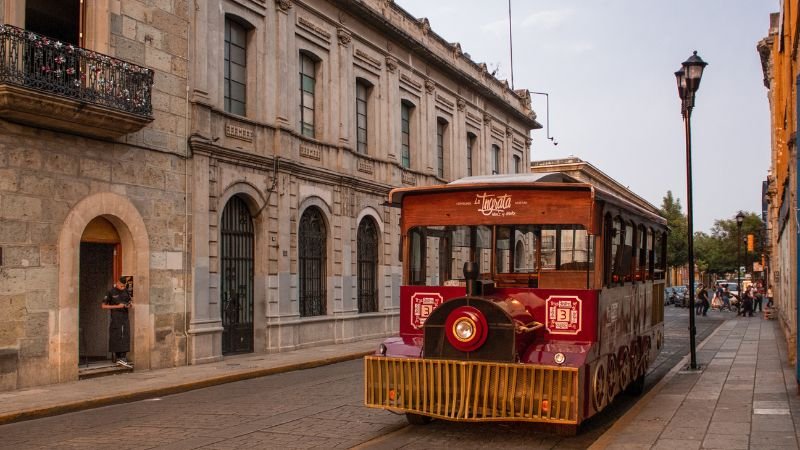
Assuming that you are now convinced that you need to visit Oaxaca for the Oaxaca Día de los Muertos festival, the next question that you probably have is how do you get there?
Well, while there are some direct flights to Oaxaca out of Dallas and Houston in Texas, the chances are good that you will fly into Mexico City on your way to Oaxaca.
From there, you’ll need to decide how you want to get from Mexico City to Oaxaca.
You might fairly think that you’ll just change flights in Mexico City and fly the rest of the way to Oaxaca (and yes, Oaxaca does have an airport, called Xoxocotlán International Airport). If you’re pressed for time, that’s certainly the best option, and flight time is only one hour and twenty minutes.
However, you’ve actually got three options from which you can choose: plane, car, or bus. It’s too far to walk or cycle, there’s no train, and unless you want to go via Panamá, you can’t go by boat.
By plane, you can fly commercially or (if you can afford it) you can also fly privately. If you travel by car, you can drive yourself or hire a private driver.
If you’re interested in finding out more, check out our article about the best way to get from Mexico City to Oaxaca.
OAXACA DAY OF THE DEAD
Where Are The Best Places To Stay In Oaxaca?
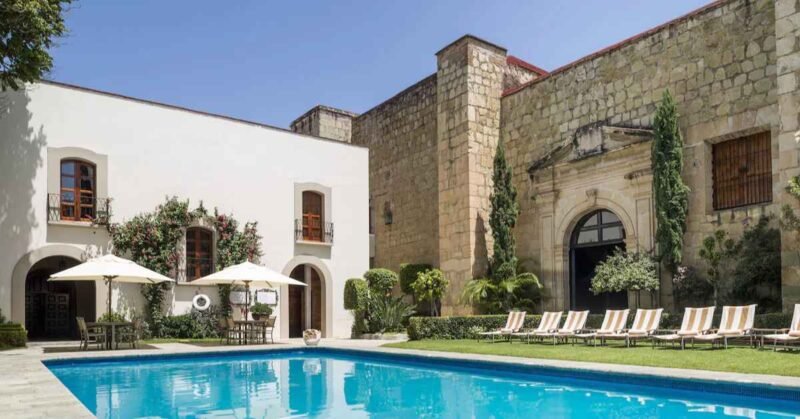
When you make it to Oaxaca, the next obvious question will be where do you stay?
Well, you’re in luck because Oaxaca has an amazing array of places to stay for you to choose from. Whatever your heart desires, you’ll find it in Oaxaca.
You can stay in a luxury hotel, such as the Quinta Real, Casa Santo Origen or the Grand Fiesta Americana.
If a boutique hotel is more your thing, you have great options such as the Palacio Borghese, the Hotel Escondido and Hotel El Callejón.
There are also amazing arty hotels like the NaNa Vida Hotel Boutique or the Pug Seal.
And if you’re travelling with a family, there are great haciendas where you can stay just outside the city. Hacienda Los Laureles Spa is a great example of these.
If you’re looking for great places to stay in Oaxaca, then check out these related articles:
- Best Hotels In Oaxaca
- Best Luxury Hotels In Oaxaca
- Best Boutique Hotels in Oaxaca
- Best Haciendas in Oaxaca
- Best Hostels in Oaxaca
You can also check prices and availability at Booking.com, Tripadvisor or Expedia.
Remember that it pays to be flexible with your travel dates. Check at least a few days on either side of your ideal travel time to secure the best deal, and also consider the shoulder seasons if you can.
And one more final important point: don’t leave it too late to book! Oaxaca Day of the Dead has become extremely popular in the last few years, and the entire city will sell out for those three days months ahead of the festival.
Best time to visit oaxaca
Final Thoughts
Hopefully you have found everything you needed to know about Oaxaca Day of the Dead.
Oaxaca is a magical place, and at no time more so than during the Oaxaca Día de los Muertos festival.
Follow the suggestions that we’ve given you above, and you’re guaranteed to have one of the best experiences of Oaxaca Day of the Dead possible.
Buen viaje!
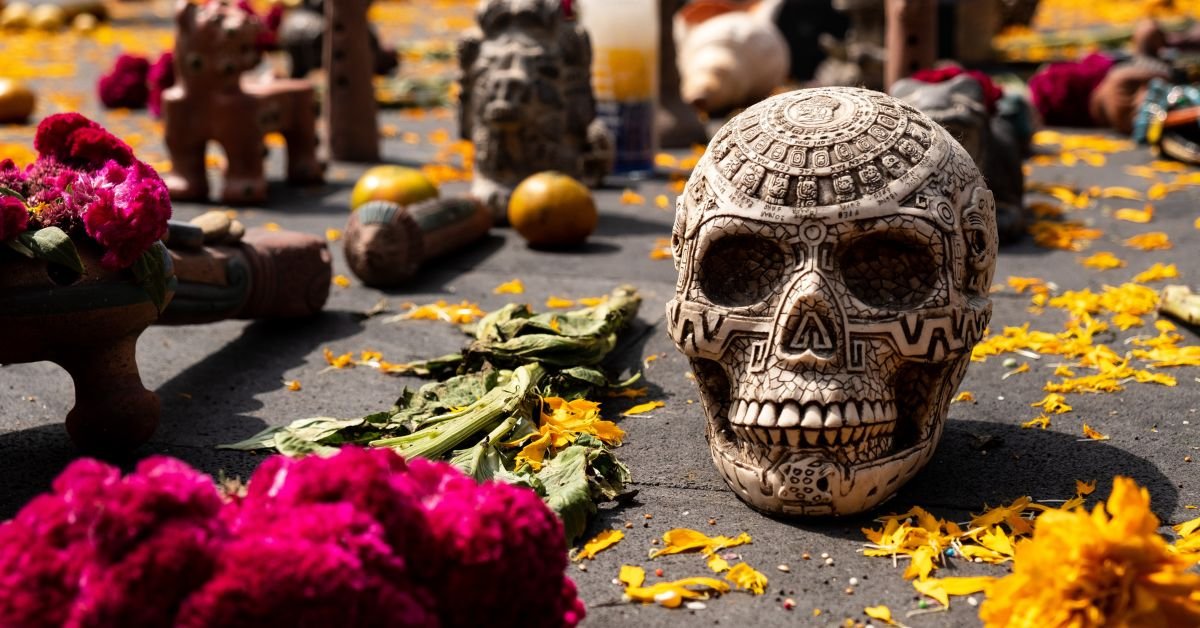
![Oaxaca To Puebla: 7 Best Ways To Travel [2024]](https://capricioustravel.com/wp-content/uploads/2023/11/Oaxaca-to-Puebla-Puebla-Cathedral-800x450.webp)
![Hotel Casona Oaxaca: The Definitive Review [2024]](https://capricioustravel.com/wp-content/uploads/2023/11/Hotel-Casona-Oaxaca-Interior-By-Night-From-1st-Floor-800x450.webp)
![Grand Fiesta Americana Oaxaca: The Definitive Review [2024]](https://capricioustravel.com/wp-content/uploads/2023/11/Grand-Fiesta-Americana-Oaxaca-Pool-Spa-Area-800x450.webp)
![Mazunte to Puerto Escondido: 5 Best Ways To Travel [2024]](https://capricioustravel.com/wp-content/uploads/2024/01/Mazunte-to-Puerto-Escondido-Punta-Cometa-and-Playa-Zicatela-2-800x450.webp)
![Cancún to Morelia: 5 Best Ways to Travel [2024]](https://capricioustravel.com/wp-content/uploads/2024/02/Cancun-to-Morelia-the-Cancun-hotel-zone-and-the-Morelia-Cathedral.webp)
![What Airport Is Closest To Oaxaca Mexico? The Ultimate Guide [2024]](https://capricioustravel.com/wp-content/uploads/2023/08/What-Airport-Is-Closest-To-Oaxaca-Mexico-1-800x419.jpg)